During their embryonic development, all chordates pass through a stage called the pharyngula [View] with these features:

- a dorsal, tubular nerve cord ("1") running from anterior to posterior. At its anterior end, it becomes enlarged to form the brain.
- a flexible, rodlike notochord ("2") that runs dorsal to the digestive tract and provides internal support. In vertebrate chordates, it is replaced by a vertebral column or backbone long before maturity.
- pairs of gill pouches. These lateral outpocketings of the pharynx are matched on the exterior by paired grooves. In aquatic chordates, one or more pairs of gill pouches break through to the exterior grooves, forming gill slits ("3"). These provide an exit for water taken in through the mouth and passed over the gills.
- a tail that extends behind the anus
There are three subdivisions of the chordates:
- Cephalochordata
- Tunicata
The cephalochordates and tunicates never develop a vertebral column. They are thus "invertebrates" and are discussed with the other invertebrates. [Link]
- Craniata
The vast majority of chordates have a skull enclosing their brain (Craniata), and all but one of these (the hagfish) convert their notochord into a vertebral column or backbone. These latter are the vertebrates.
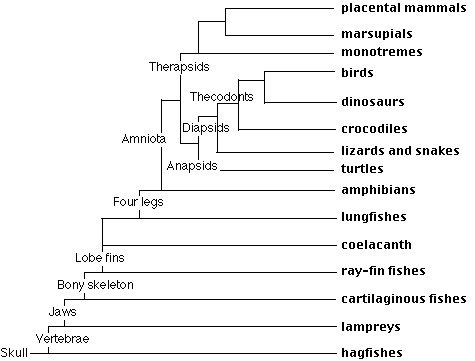 The craniata, as their name implies, have a skull (containing brain, eyes, inner ear, etc.).
One group, the hagfishes, never replaces their notochord with a vertebral column, and thus are — strictly speaking — invertebrates. However, they are traditionally linked with the vertebrates.
All the other members of the craniata convert their notochord into a vertebral column or "backbone" (even though in some it is made of cartilage not bone). They also differ from all other animals in having quadrupled their HOX gene cluster; that is, they have 4 different clusters of HOX genes (on 4 separate chromosomes). Perhaps this acquisition played a key role in the evolutionary diversity that so characterizes the vertebrates.
The craniata, as their name implies, have a skull (containing brain, eyes, inner ear, etc.).
One group, the hagfishes, never replaces their notochord with a vertebral column, and thus are — strictly speaking — invertebrates. However, they are traditionally linked with the vertebrates.
All the other members of the craniata convert their notochord into a vertebral column or "backbone" (even though in some it is made of cartilage not bone). They also differ from all other animals in having quadrupled their HOX gene cluster; that is, they have 4 different clusters of HOX genes (on 4 separate chromosomes). Perhaps this acquisition played a key role in the evolutionary diversity that so characterizes the vertebrates.
The vertebrates are subdivided into the
- jawless vertebrates (Agnatha) and the
- jawed vertebrates (Gnathostomata)
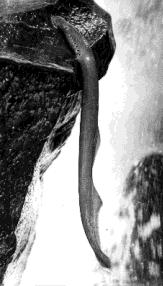
Lampreys are the only jawless vertebrates to survive today. They are the most primitive of the vertebrates. By "primitive", a biologist means that they are the least changed from the first vertebrates.
Besides lacking jaws,
- They have no paired pectoral (shoulder) or pelvic (hip) fins.
- Their notochord persists for life, never being completely replaced by a backbone.
- They have no scales.
- The axons of their neurons are unmyelinated (like those of all invertebrates).
- And like invertebrates, they have only an innate immune system.
The photo (courtesy of the Carolina Biological Supply Company) is of the West Coast lamprey. Note the gill slits and the absence of paired pectoral and pelvic fins.
As well as having jaws, all the members of this group have
- myelin sheaths around the axons of their neurons. This permits much more rapid transmission of nerve impulses — a trait probably as important for active vertebrates as their jaws.
- an adaptive immune system backing up their innate immune system.
The earliest cartilaginous fishes appeared late in the Devonian period. They were very much like the sharks of today.
The group, which today is made up of some 800 species of
gets its name from the fact that their skeleton is made of cartilage, not bone.
With their gills exposed to sea water, all marine fishes are faced with the problem of conserving body water in a strongly hypertonic environment. Sea water is about 3.5% salt, over 3 times that of vertebrate blood. The cartilaginous fishes solve the problem by maintaining such a high concentration of urea in their blood (2.5% — far higher than the 0.02% of other vertebrates) that it is in osmotic balance with — that is, is isotonic to — sea water.
This ability develops late in embryology, so the eggs of these species cannot simply be released in the sea. Two solutions are used:
- Enclose the egg in an impervious case filled with isotonic fluid before depositing it in the sea.
- Retain the eggs and embryos within the mother's body until they are capable of coping with the marine environment.
Both these solutions require internal fertilization, and the cartilaginous fishes were the first vertebrates to develop this. The pelvic fins of the male are modified for depositing sperm in the reproductive tract of the female.
As their name indicates, the skeleton in this group is made of bone.
The group is subdivided into the
- ray-finned fishes (Actinopterygii) and
- lobe-finned fishes (Sarcopterygii)
- Their fins are thin and supported by spines.
- There are some 25,000 species (representing more than half of all living vertebrates).
- They are an important part of the human diet in many areas of the world and, in affluent nations, support a large sports fishing industry.
The earliest bony fishes appear in freshwater deposits of the Devonian period. In addition to gills, these fishes had a pair of pouched outgrowths from the pharynx which served as lungs. They were inflated with air taken in through the mouth and may have provided a backup gas exchange organ when the water became too warm and stagnant to carry enough dissolved oxygen. Their kidneys were adapted for the hypotonic environment in which they lived. [Illustrated discussion]
These animals diversified through the remainder of the Devonian period (which is often called the "Age of Fishes"). Some migrated to the oceans. In this more stable environment, their lungs became transformed into a swim bladder with which they could alter buoyancy. Their kidneys became transformed as well adapting them to their new — hypertonic — surroundings. [Link to discussion]
The only ones to survive today are:
- one — possibly two — species of coelacanth. Coelacanths were long thought to have become extinct at the end of the Mesozoic era, some 70 million years ago. But in December 1938, a living coelacanth, Latimeria chalumnae, was pulled up from the depths of the ocean off the east coast of Africa. Since then, over 200 additional specimens have been caught.
- several species of lungfish found in Africa, South America, and Australia.
The nostrils of bony fishes open only to the outside and are used for smelling. Some of the lobe-finned fishes developed internal openings to their nostrils. This made it possible to breath air with the mouth closed as modern lungfishes do.
Judging from present-day lungfishes, two other significant adaptations evolved in this group:
- two atria and a partial septum in the ventricle of the heart. This permitted a partial separation of oxygenated blood returning from the lung(s) and the deoxygenated blood returning from the rest of the body.
- an enzyme system to convert ammonia into the less toxic urea. This mechanism is highly-developed in the African and South American lungfishes. While in the water, these fishes excrete their waste nitrogen as ammonia, just as most ray-finned fishes do. In time of drought, these animals burrow in the mud and switch to urea production.
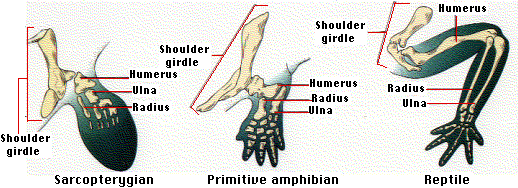
These rare modern lobe-finned fishes are the sole survivors of once-flourishing groups that also gave rise to the tetrapods — the four-legged vertebrates. Late in the Devonian (about 360 million years ago), the paired fins of some sarcopterygians moved under the body and developed digits. This enabled them to venture out on land. So once again, evolution was opportunistic giving rise to the first land vertebrates, the amphibians.
The figure shows the relationship between the bones of the tetrapod foreleg and the pectoral fin of a sarcopterygian.
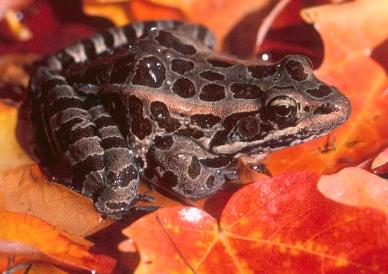 With their bony limbs and lungs inherited from their lobe-finned ancestors, amphibians were so successful during the Carboniferous (Mississippian and Pennsylvanian periods) that these periods are known as the Age of Amphibians.
With their bony limbs and lungs inherited from their lobe-finned ancestors, amphibians were so successful during the Carboniferous (Mississippian and Pennsylvanian periods) that these periods are known as the Age of Amphibians.
The Carboniferous was followed by the Permian, when the earth became colder and dryer. The fortunes of the amphibians began to decline until only three groups — totaling about 5700 species — remain today:
- frogs and toads (Anura) (The one pictured is Rana pipiens, the leopard frog.)
- salamanders and newts (Urodela)
- caecilians (Apoda), which are rare, limbless, tropical animals.
As the name suggests, amphibians are only semiterrestrial:
- their skin is soft and moist so they are at risk of desiccation in dry surroundings
- their eggs have no waterproof covering so
- they must be laid in water (which makes them useful animals for studying embryonic development) where they are fertilized or
- placed within the mother's body (some use a pouch in the skin, some use their mouth, some even use their stomach — which stops secreting acid and enzymes for the duration!) after external fertilization.
| Link to descriptions of the heart and kidneys of amphibians. |
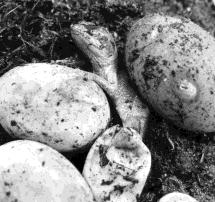
Reptiles evolved from amphibians during the Carboniferous. With the arrival of the cold, dry Permian, they were well-adapted to survive because of their development of a shelled, yolk-filled egg which could be deposited on land without danger of drying out.
The photo (courtesy of the Carolina Biological Supply Company) shows an American chameleon emerging from its egg.
A shelled egg is just as impervious to sperm as to water, so its arrival coincided with the development of internal fertilization.
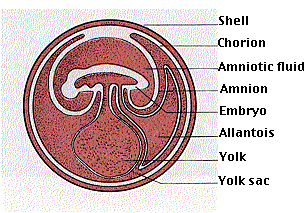 The embryo developing within the egg produces 4 extraembryonic membranes: the
The embryo developing within the egg produces 4 extraembryonic membranes: the
- chorion, which serves for gas exchange
- amnion, which surrounds the embryo with a fluid as watery as the pond water around a frog's egg
- allantois, which serves both for gas exchange and to store metabolic wastes
- yolk sac, which supplies the embryo with food
The amniotic egg was such a successful adaptation for land living that it has been retained by:
- all modern reptiles as well as by their descendants
- the birds
- and mammals (modified to form a placenta in most of the latter).
Collectively, these three groups as often called the Amniota.
Other adaptations that enabled the reptiles to flourish for the next 220 million years were:
- a dry, water-impermeable skin
- lungs inflated by expansion of the rib cage
- a partial septum in the ventricle reducing the mixing of oxygenated and deoxygenated blood [Link to illustrated discussion]
The reptiles underwent a remarkable adaptive radiation producing five major lines of descent:
- Pelycosaurs which had their legs under, rather than at the sides of, the body. This permitted more rapid running on land.
- Soon a group of small, active land-dwelling therapsids evolved from these and, 100 million years later, they produced the
- mammals.
- Turtles (Chelonia). Some 250 species survive today. Although most live in fresh or salt water, they reveal their terrestrial heritage by returning to the land to lay their eggs.
- Plesiosaurs and
- Ichthyosaurs (both marine reptiles that became extinct by the end of the Mesozoic era)
- Diapsids
The dominance of the reptiles during the Mesozoic era has giving it the name, the Age of Reptiles.
This group developed the ability to convert their nitrogenous waste into uric acid. Uric acid is almost insoluble in water so its excretion involves little loss of water. (It is the whitish paste that pigeons leave on statues.) This modification largely freed the diapsids and their descendants from a dependence on drinking water; the water in their food is usually sufficient.
Diapsid evolution soon produced:
- lizards and snakes (Squamata — some 6,300 species survive today).
- thecodonts
Thecodonts were able to run fast by rising up on their hind legs, which became larger than their front legs, and using their long tail for balance. The group diversified into:
- crocodiles and alligators (Crocodilia — 22 species survive today)
- an extraordinary array of dinosaurs from some of which evolved today's birds.
Feathers are the feature that most clearly distinguishes the birds from their dinosaur ancestors. These scaly skin outgrowths provide
- a light, strong surface for the wings
- heat insulation, making it possible to be small but still warm-blooded
Other adaptations are:
- hollow bones
- a single gonad (in females), which becomes enlarged and active only during the breeding season
- no teeth (their function is replaced by the gizzard)
- powerful breast muscles attached to an enlarged sternum
- a four-chambered heart
All of these adaptations help birds to fly (to escape predators and find suitable food and nesting sites). Approximately 10,000 species are know today.
Features:
- milk secreted from mammary glands
- hair; conserves body heat permitting even tiny mammals to be warm-blooded
- teeth specialized for cutting (incisors), tearing (canines) and grinding (molars) their food
- about 4,600 species living today
Mammals first appeared over 180 million years ago early in the Mesozoic. They were the
- Prototheria ("first beasts") and
- Theria
The only prototheria to survive until now are the monotremes: the duckbill platypus and two species of spiny anteaters (echidnas). These animals lay eggs as their therapsid ancestors did.
Although the therians diverged into the
- Metatheria (marsupials) and
- Eutheria (placental mammals)
some 140 million years ago, it was not until late in the Mesozoic that they began an extensive adaptive radiation. By the dawn of the Cenozoic, they had evolved into:
- 7 orders of marsupials (Metatheria) and
- 18 orders of placental mammals (Eutheria), containing some 4500 species,
and fully justifying our calling the Cenozoic the Age of Mammals.
Developing marsupial are retained for only a brief time within the reproductive tract of the mother. During this time they receive some nourishment from the yolk sac which grows into the wall of the uterus. They are born at such an early stage of development [View] that they must crawl into a pouch on the mother's abdomen, attach themselves to one of her milk-dispensing nipples, and complete development there.
Only one marsupial, the opossum, survives in North America; some 69 species in South America. In Australia, however, where they were protected far longer from an influx of placental mammals, there is still an broad array of marsupials [View, for example, the wombat].
These animals retain their young within the mother until development is well along. The egg contains little yolk, but the extraembryonic membranes form an
- umbilical cord and
- placenta
through which the young secure nourishment (and oxygen) from their mother.
The table shows the orders of placental mammals (Eutheria) and representatives of each.
The members of orders shown with the same color belong to a single clade; that is, they are more closely related to each other than to the mammals in any other orders.
These clades are based on the most recent analysis of DNA sequences of several genes — both nuclear and mitochondrial — and the building of phylogenetic trees from these data.
| Tubulidentata |
aardvarks |
| Macroscelidea |
elephant shrews |
| Hyracoidea |
hyraxes |
| Sirenia |
manatee, dugong |
| Proboscidea |
elephants |
| Cingulata |
armadillos |
| Pilosa |
anteaters, sloths |
| Dermoptera |
flying lemurs |
| Scandentia |
tree shrews |
| Primates |
lemurs, New World monkeys, Old World monkeys, great apes (hominoids), humans |
| Rodentia |
rats, mice, squirrels, beaver |
| Lagomorpha |
rabbits, hares |
| Insectivora |
shrews, moles |
| Chiroptera |
bats |
| Pholidota |
scaly anteaters |
| Carnivora |
dogs, cats, lion, skunk, walrus, sea lion |
Perissodactyla
(odd-toed ungulates) |
horse, zebra, rhinoceros |
Artiodactyla
(even-toed ungulates)
|
cow, sheep, pig
giraffe, hippopotamus |
| Cetacea |
whales, dolphins, porpoises |
Afrotheria
The 5 orders shown in yellow are found in Africa. They appear to be the most primitive of the placental mammals.
Xenarthra
These animals (armadillos, sloths, giant anteaters) probably arose in the part of Gondwana that today is South America.
Euarchontoglires
The hugely-successful glires (rodents and rabbits) form a clade (light blue) that is so closely related to the clade that includes the flying lemurs, tree shrews, and primates (dark blue) that they are grouped together.
Laurasiatheria
These 7 orders, shown in green, have been assigned to the Laurasiatheria because they are first found in the supercontinent of Laurasia. [ map and discussion ]
The even-toed ungulates and the cetaceans turn out to be so closely related that they are now being placed in a single order the Cetartiodactyla. In fact, hippos appear to be more closely related to the cetaceans than they are to the other even-toed ungulates.
What explains the long period of insignificance of the placental mammals followed by such a burst into prominence? It was not until the extinction of so many reptiles at the end of the Mesozoic (perhaps caused by one or more asteroids striking the earth 65 million years ago — Discussion) that a variety of habitats opened up for occupancy by the mammals, for example,
- ungulates replaced the herbivorous dinosaurs
- cetaceans replaced the plesiosaurs
7 September 2005




 With their bony limbs and lungs inherited from their lobe-finned ancestors, amphibians were so successful during the Carboniferous (Mississippian and Pennsylvanian periods) that these periods are known as the Age of Amphibians.
With their bony limbs and lungs inherited from their lobe-finned ancestors, amphibians were so successful during the Carboniferous (Mississippian and Pennsylvanian periods) that these periods are known as the Age of Amphibians.

 The embryo developing within the egg produces 4 extraembryonic membranes: the
The embryo developing within the egg produces 4 extraembryonic membranes: the